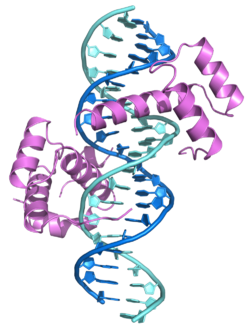Top Qs
Timeline
Chat
Perspective
PBX1
Protein found in humans From Wikipedia, the free encyclopedia
Remove ads
Pre-B-cell leukemia transcription factor 1 is a protein that in humans is encoded by the PBX1 gene.[5] The homologous protein in Drosophila is known as extradenticle, and causes changes in embryonic development.
Remove ads
Function
Mice studies suggest PBX1 is involved in bone generation and skeletal patterning.[6]
Interactions
PBX1 has been shown to interact with:
Fruit fly homolog
The Drosophila melangoster gene called extradenticle encodes a homeodomain protein that is 71% similar to the Pbx1 protein, and is considered homologous to PBX1.[14] extradenticle is a homeodomain transcription factor[15] expressed during embryogenesis and is related to morphological changes and development.[14]
Reduced levels of extradenticle cause segmental transformations, without affecting the functionality or location of homeotic genes. Complete removal of extradenticle both maternally and zygotically leads to alterations from failure of non-extradenticle protein expression.[16]
A monoclonal antibody study of the expression of extradenticle protein in embryonic development found that it is uniformly distributed, as well as excluded from cell nuclei, until gastrulation. During the germ band retraction stage of development, extradenticle protein begins to accumulate in the nuclei of cells in a specific pattern. Proximal areas of wing and leg imaginal discs have extradenticle present in the nucleus, while distal areas only have it in the cytoplasm.[17]
References
Further reading
External links
Wikiwand - on
Seamless Wikipedia browsing. On steroids.
Remove ads






